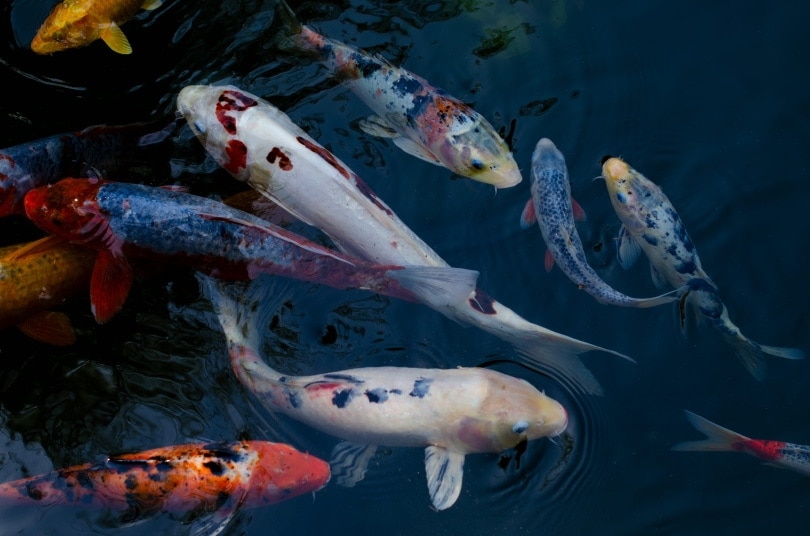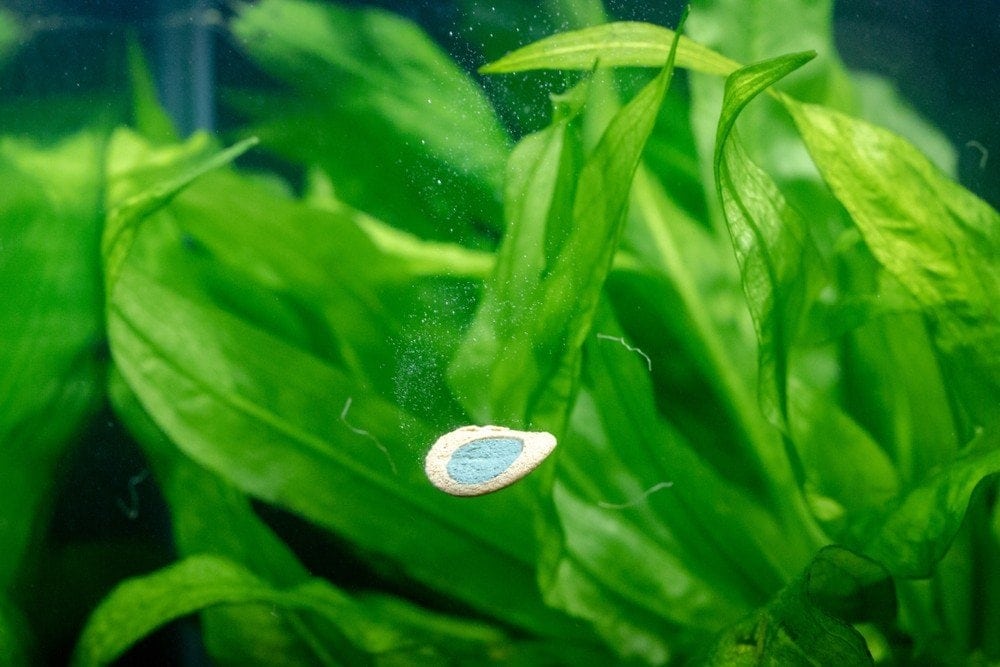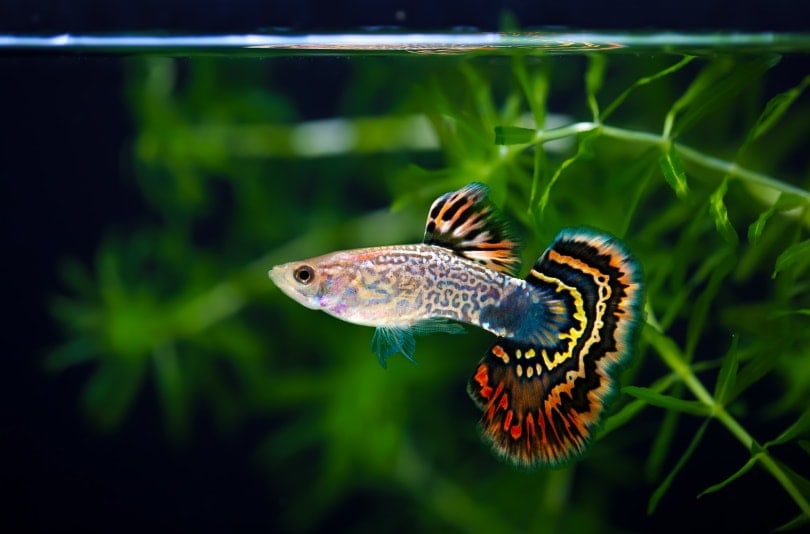Cardinal Tetra vs Neon Tetra: Comparison, Facts & FAQs (Vet-Approved Info)

Updated on
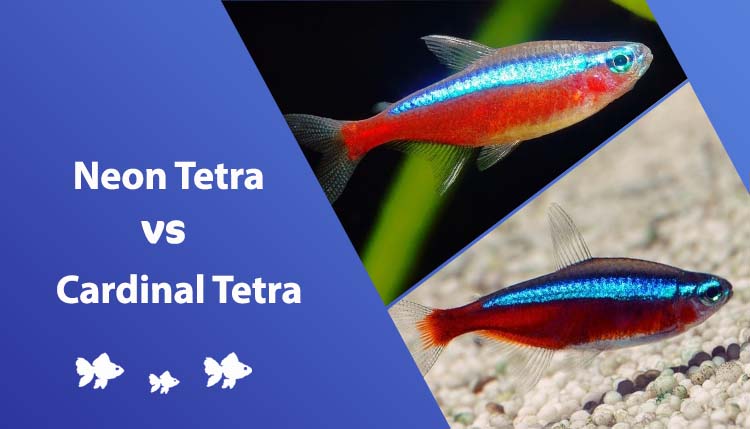
If you like small, peaceful, and brightly colored fish, you might have looked into getting some tetras. However, there are lots of different tetra varieties to choose from, with the neon tetra and the cardinal tetra being two of the most popular options.
Let’s do a little neon tetra vs cardinal tetra comparison, so you can make an informed choice in terms of which fish is better for your home aquarium.
At a Glance
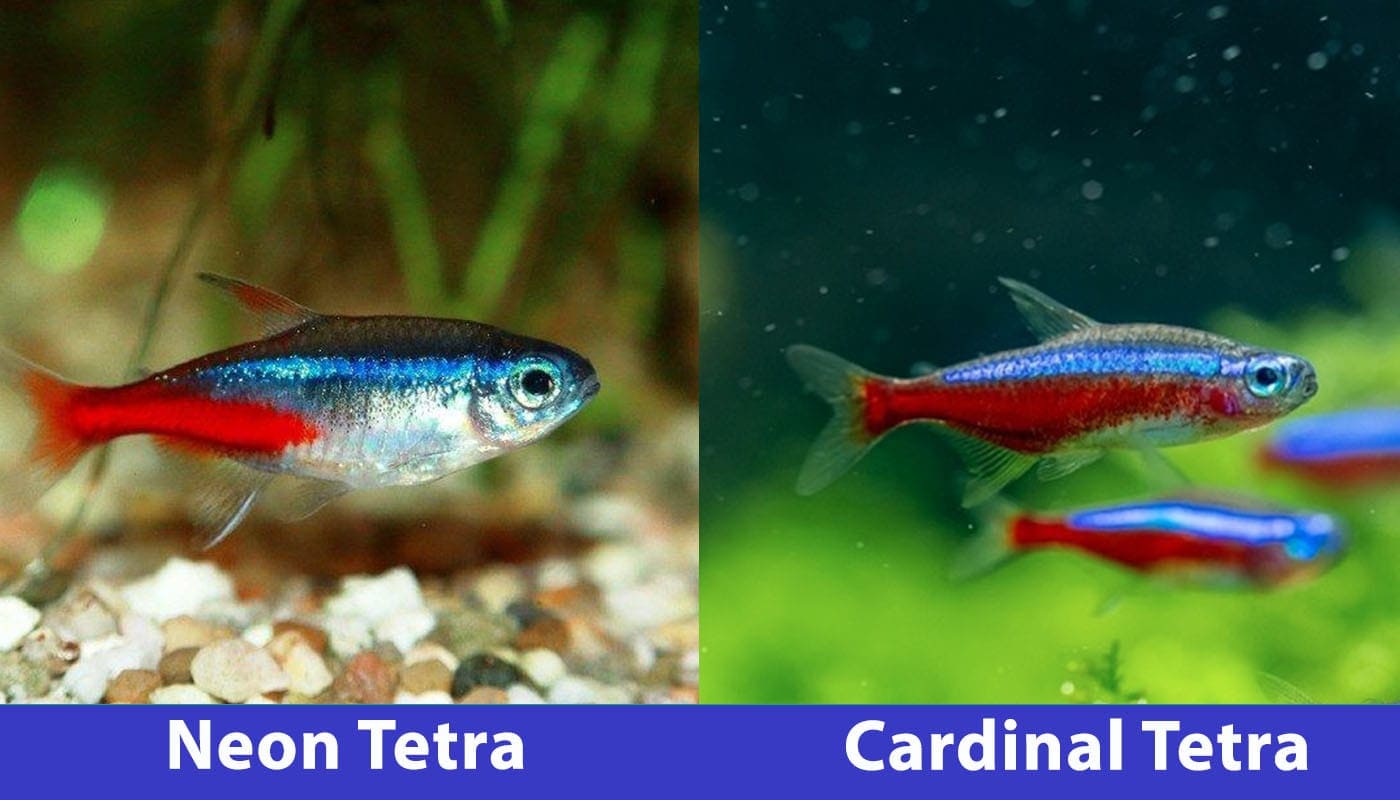
- Average length (adult): 1.5–1.5 inches
- Lifespan: 5 years (average estimate)
- Habitat requirements: For a school of 15 fish, a 20-gallon tank minimum
- Colors: Turquoise and red
- Average length (adult): 1.25–2 inches
- Lifespan: 5 years (average estimate)
- Habitat requirements: For a school of 15 fish, a 25-gallon tank minimum
- Colors: Similar to neon, but with more red
 Neon Tetra (Paracheirodon innesi)
Neon Tetra (Paracheirodon innesi)
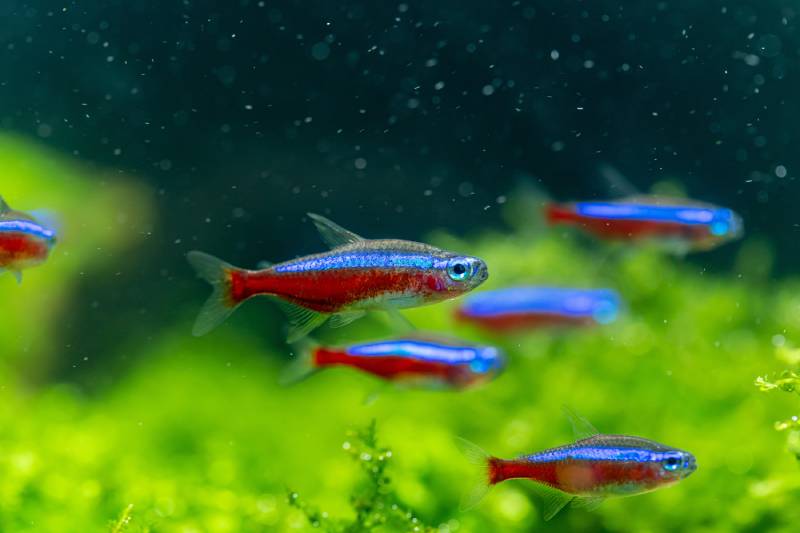
Origins
The neon tetra fish originates from the Amazon jungle and can be found throughout many countries in South America. It is a freshwater fish that belongs to the Characidae family.
It’s a good community fish, with over 2 million of them being sold per month in the US alone.
Size, Appearance, & Lifespan
What really stands out about this fish is their awesome coloration, and one of the first things which people tend to notice is the dazzling turquoise line that stretches from right under their eye to the front of the tail.
You will also notice that the neon tetra has a bright red line on their side that starts at the middle of the body and runs down to the caudal fin.
The color combination makes them extremely recognizable, and it is thought that they have these bright iridescent colors in order so that neon tetras can locate each other in murky waters.
These fish have a body that resembles a spindle with a rounded nose. At the very most, the neon tetra can possibly grow to 2 inches in length, but they usually realistically top out at around 1.5 inches long.
In terms of lifespan, the maximum age for the neon is anecdotally around 8 years, but generally speaking, they will top out at 5 years of age.
Tank Size & Habitat
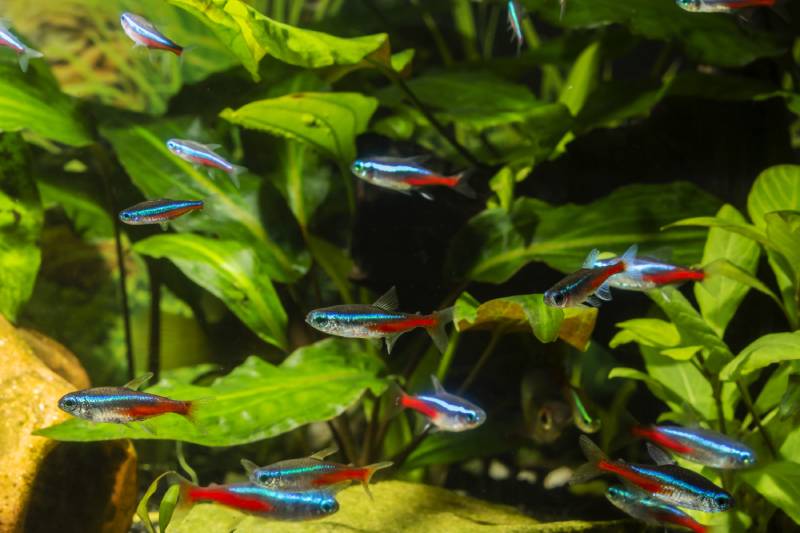
In terms of tank size, the minimum size for a small school of neon tetras, so about 7 or 8 fish, is 10 gallons.
However, what you need to know is that it is recommended that neon tetras be kept in schools of at least 15 fish, and for this amount of fish, you will want a tank of 20 gallons at the least.
The most important thing to remember when it comes to recreating the natural habitat of the neon tetra is that they always live in heavily vegetated areas characterized by fairly low light levels and slow-moving waters.
You want to have a lot of live plants in a neon tetra tank, along with some rocks and several pieces of driftwood too. Although a bit of light is required for them, these fish are used to darker conditions, so nothing special is required in terms of lighting.
Water Conditions
When it comes to water conditions, your average neon tetra can survive just fine in waters between 20–28 °C (68–82 °F), so you will most likely need to get a heater for the tank. Moreover, in terms of pH level, between 5.5 and 7.5 will do just fine. These fish can adapt to a wide range of water hardness; any constant value between 1–15 dH should be adequate.
What is nice about neon tetras is that they have a small bioload, and they don’t produce much waste, so although you do want to have a filtration unit for them, it also does not have to be anything overly special.
Feeding
Neon tetras in the wild are omnivores, so they will eat both small animals and insects, as well as plant matter too. They are not picky eaters and will eat more or less anything you give them, as long as they can fit it in their mouths.
They will often snack on algae and maybe even on some of the plants in your tank. Neon tetras will eat both flakes and pellets, plus you can give them Tubifex worms, brine shrimp, blood worms, and daphnia too.
Some boiled and shelled peas can be given to them as well. However, just keep in mind that they are small fish, so all food needs to be in very small pieces.
Compatibility & Behaviour
What’s also nice about the neon is that it is a very peaceful fish. They’re peaceful, they’re not territorial, and they’re not aggressive, which makes them a great type of fish for a community tank.
However, just beware that much larger and more aggressive fish may pick on these little guys. Please note that Angelfish are natural predators of neon tetras and shouldn’t be housed with them, despite them occupying the same natural geographical habitat.
Cardinal Tetra (Paracheirodon axelrodi)
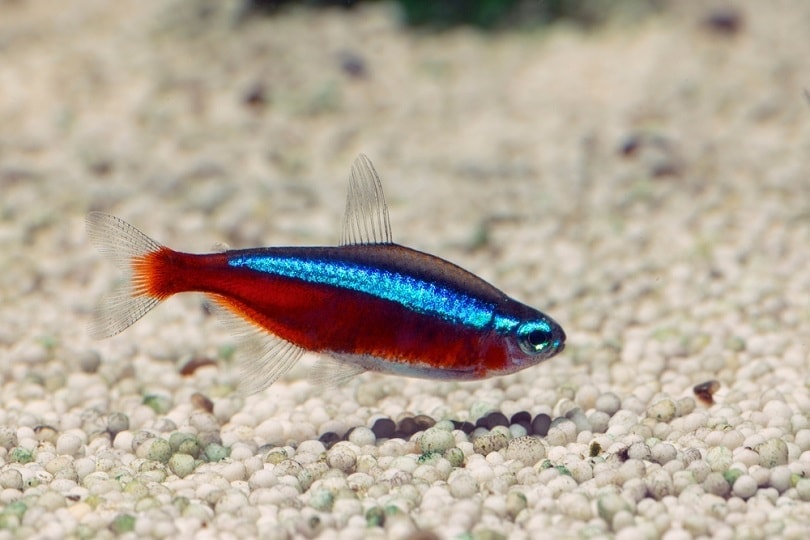
As you will notice, the cardinal tetra is very similar to the neon tetra, with small differences in appearance, as well as some stricter care rules.
The cardinal tetra (or Paracheirodon axelrodi) is slightly more difficult to care for than the neon tetra.
Origins
The cardinal tetra can also be found in many South American countries, mainly in Brazil, Colombia, and Venezuela, the northern parts of South America.
They can be found in both the Amazon rainforest as well as other smaller rainforests all throughout this area. Keep in mind that the cardinal tetra is also sometimes referred to as the red neon tetra.
Size, Appearance, & Lifespan
In terms of appearance, the cardinal tetra does look similar to the neon tetra but with a whole lot more red. The cardinal tetra does feature that same neon blue-turquoise stripe running from the eye to the tail, but unlike the neon tetra, the cardinal tetra has much more red on their side, all the way from that blue stripe down to the white underbelly.
The red band on the cardinal tetra runs from its face to tail, whereas with the neon tetra, it starts only halfway along the body towards the back. Other than that, neon tetras and cardinal tetras do have the same spindle body shape with a rounded nose.
They are also roughly the same size, although cardinal tetras are slightly larger. They grow to a maximum of 2 inches in length, but some individuals can exceed this. Like neon tetras, they will usually live to around 5 years in captivity.
Tank Size & Habitat
In terms of the tank size, the requirements for the cardinal tetra are pretty much the same as for the neon tetra. These fish should ideally be kept in schools of 15, and for this amount of fish, you want an aquarium that is at least 20 gallons, although something slightly larger, such as a 25-gallon tank, is probably better.
These fish are used to the same waters as neon tetras, which means you should provide them with very slow-moving waters, a tank that is very heavily vegetated with live plants, some rocks, and several pieces of hollow driftwood too.
They don’t need all that much light, as they are also used to murky waters, but you do still want to get a small aquarium light – it’s best to find a light that caters to the needs of your live plants.
As with neon tetras, you do want to provide them with a bit of open swimming space in the center of the tank.
Water Conditions
This is where things do get a little trickier because, unlike neon tetras which will do fine in a variety of conditions, cardinal tetras have slightly stricter requirements than neon tetras, especially when it comes to their temperature requirements.
The water temperature for a cardinal tetra needs to be between 24–30 °C (75–86 °F) with a pH level between 5.5 to 7.5 and a water hardness level similar to that of neon tetras. Cardinal tetras don’t have a huge bioload, but a good 3 stage filtration unit will still serve them well.
Feeding
When it comes to feeding, the cardinal tetra is predominantly a predator, though they will occasionally eat plant matter too. As such, they do best on a high-protein diet intended for carnivores, with supplements of plant matter offered every now and then.
You can give them Tubifex worms, brine shrimp, blood worms, and daphnia too. Just remember that all food needs to be small enough for their tiny mouths to eat.
Compatibility & Behaviour
Just like the neon tetra, the cardinal tetra is a non-aggressive and non-territorial schooling fish, a peaceful fish that makes for a good community tank mate. As long as they are not kept with much larger and more aggressive fish, they will do just fine.
You definitely don’t want to keep them with any fish that are known for eating smaller slim-bodied fish.
FAQs
Will Cardinal Tetras School with Neons?
Surprisingly, no. Despite their similar appearance (at least to us), these fish do not tend to school together and tend to only school with their conspecifics instead.
Which Out of The Two Is Better For A Beginner?
Both neon tetras and cardinal tetras are great fish for beginners. As noted above, in terms of tank mates, water conditions, water chemistry, feeding, spatial requirements, and more, both of these fish species are virtually identical in their needs.
The only real difference between the two is that neon tetras are far more susceptible to disease than cardinal tetras. The cause of this is thought to be that neon tetras are mass-produced in fish farms, whereas cardinal tetras are usually not. Chief among these diseases is neon tetra disease, which, despite the name, isn’t exclusive to just neon tetras (but is most commonly seen in this species). This disease has no known cure.
This mass production of fish, just like with anything else in the world, usually results in a lower quality level, which in this case means that neon tetras usually have weaker immune systems.
Therefore, you need to be much more careful with neon tetras than with cardinals in terms of clean water and tank cleaning, water conditions, and feeding. Neon tetras get sick much easier than cardinal tetras.
Final Thoughts
At the end of the day, you do have a choice to make here. On one hand, the neon tetra is probably a bit easier to care for, but on the other hand, the cardinal tetra does look a bit cooler for some people.
With that being said, if you do it right and keep the water conditions ideal to suit both types of fish, there is no reason why you cannot keep both neon and cardinal tetras in the same community tank.
Featured Image Credit: (L) Grigorev Mikhail, Shutterstock, (R) InsectWorld, Shutterstock


 Neon Tetra (Paracheirodon innesi)
Neon Tetra (Paracheirodon innesi)

